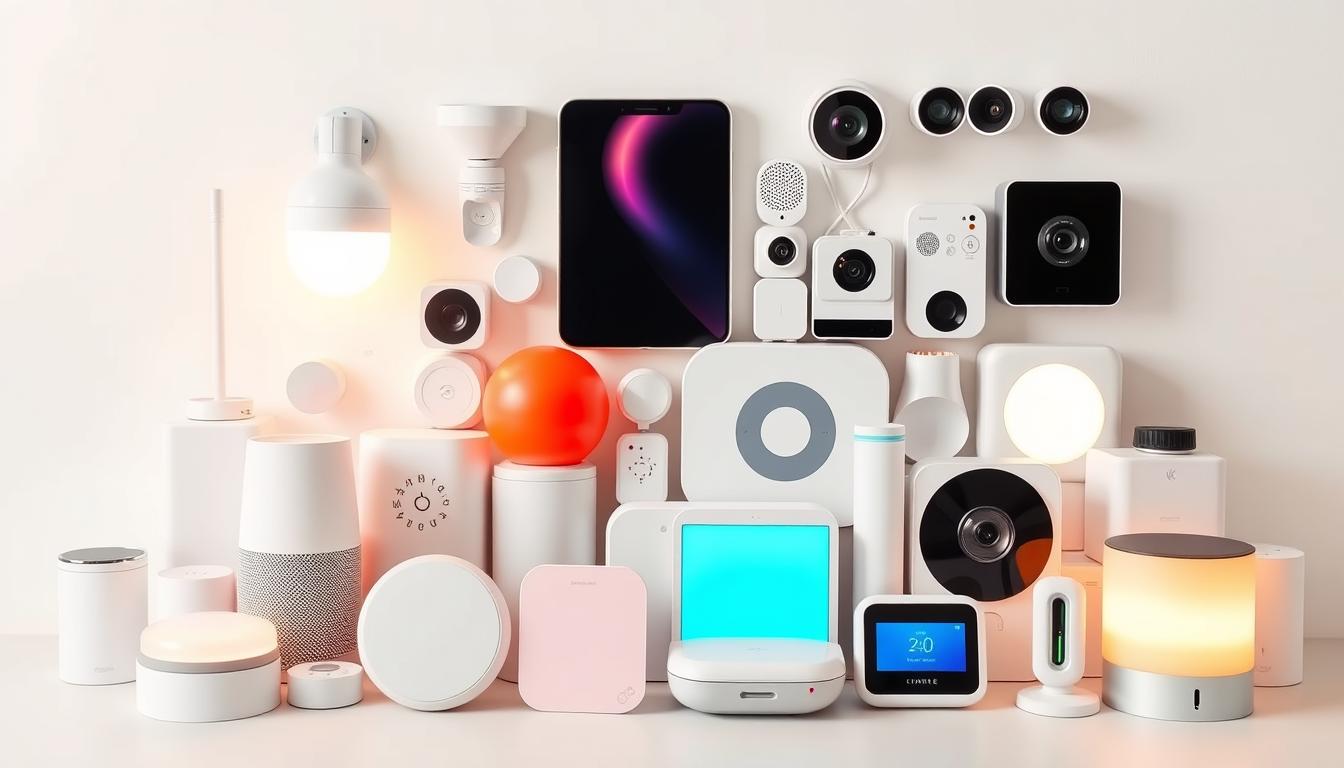Imagine waking up to a connected home that adjusts to your needs. With smart home solutions, your living space can be automated. This makes your life more comfortable, secure, and efficient.
You can control many parts of your life with home automation and iot devices. This includes lighting, temperature, and security systems. A connected life is now easier than ever.
Exploring smart living brings many benefits. This article will show you how to make your life more connected and efficient.
Key Takeaways
- Understand the concept of a connected life with smart home solutions.
- Learn how home automation can simplify your daily tasks.
- Discover the role of iot devices in enhancing your living experience.
- Explore the benefits of integrating technology into your home.
- Find out how to create a more efficient and secure living space.
The Evolution of Smart Home Technology
Smart home tech has grown a lot. It started with simple automation and now it’s complex. You can control lights, temperature, security, and entertainment with your phone or voice.
From Science Fiction to Reality
Smart homes were once just a dream. But now, thanks to IoT (Internet of Things), they’re real. Devices talk to each other, making life easier for homeowners.
Some big changes include:
- Voice assistants like Amazon Alexa and Google Assistant
- Smart thermostats that learn your temperature likes
- Automated lights that change with the day
- Advanced security systems that watch your home
Key Milestones in Home Automation
The journey of home automation has hit many big points. From the first smart devices to full smart home systems. Key moments include:
- The first smart thermostats came out
- Smart lights that you can control from afar
- Security cameras and smart doorbells with video
These changes have made our homes better. They’re more comfy, safe, and save energy.
What Is a Smart Home?
A smart home is a place where everything works together. It uses technology to make your home more comfortable, safe, and efficient. This makes your life easier every day.
Core Components of a Connected Home
A connected home, or smart home, has key parts to work well. These include IoT devices, a strong IoT platform, and a central hub. IoT devices are things like smart thermostats and security cameras.
“The beauty of a smart home lies in its ability to learn and adapt to your preferences over time,” says an expert in home automation.
These devices talk to each other and the central hub. This lets you have a living experience that’s just for you. For example, your smart home can change the lights and temperature based on what you’re doing.
The Role of IoT in Modern Living
The Internet of Things (IoT) is key in modern homes, especially smart homes. IoT devices and platforms connect your home’s appliances and systems. This lets you control and watch them from anywhere.
This makes your home more convenient, saves energy, and keeps it safe. With IoT, you can manage your home’s systems from one place. This includes changing the thermostat or turning on lights.
As technology gets better, IoT’s role in making homes connected and smart grows. This is very important for our living spaces today.
Benefits of Creating a Smart Home
Smart home devices make living easier, safer, and more energy-efficient. They integrate technology to automate your home. This makes life more convenient and fun.
Convenience and Time Savings
Smart homes let you control lights, temperature, and entertainment from anywhere. This saves time and makes life better.
Enhanced Security and Safety
Home security is a big plus of smart homes. You can watch your home with smart doorbells, cameras, and locks. This gives you peace of mind, no matter where you are.
Energy Efficiency and Cost Reduction
Smart homes save energy by adjusting heating, cooling, and lights. This cuts down your bills and helps the planet.
Accessibility and Aging in Place
Smart homes are great for people with mobility issues or aging in place. They offer voice control and automated systems. This makes daily tasks easier and keeps independence.
| Benefit | Description | Example |
|---|---|---|
| Convenience | Control over various home systems | Remote lighting control |
| Security | Enhanced monitoring and control | Smart doorbells and cameras |
| Energy Efficiency | Optimized energy consumption | Smart thermostats |
| Accessibility | Ease of use for all ages | Voice-controlled systems |
Essential Smart Home Hubs and Controllers
In the world of smart homes, hubs and controllers are key. They make sure all devices work together. A smart home hub or controller is like a central command center. It connects and manages smart devices, letting them talk to each other and be controlled from one place.
Popular Smart Home Platforms
Many smart home platforms are popular because they are easy to use and work well with different devices. They support various technologies, making it simple to add new devices.
Wi-Fi Based Systems
Wi-Fi based smart home systems are common because they are easy to set up and work with many devices. They use your home’s Wi-Fi, so you don’t need a separate hub in some cases.
Z-Wave and Zigbee Technologies
Z-Wave and Zigbee are wireless protocols used in smart home devices. They use little power, send data securely, and help devices connect better, making your network stronger.
Matter Protocol and Compatibility
The Matter protocol is a new standard that makes smart home devices from different brands work better together. It makes setting up your smart home easier and lets you mix devices from different brands.
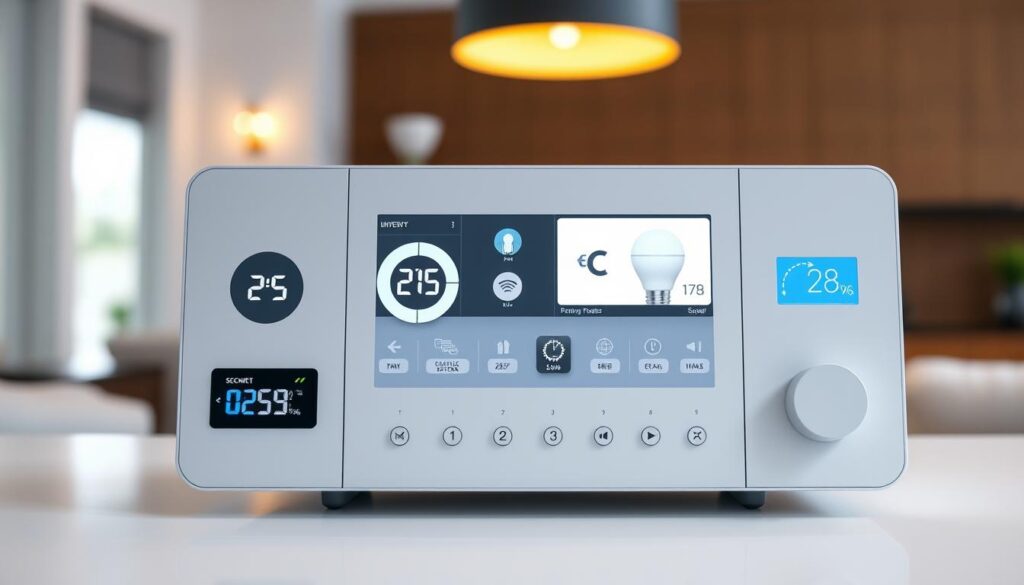
Choosing the Right Hub for Your Needs
Choosing the right smart home hub or controller depends on a few things. These include the devices you want to connect, your budget, and how much automation you want. Here are some things to think about:
- Device compatibility: Make sure the hub works with your devices.
- Ease of use: Pick a hub with an easy-to-use interface and app.
- Automation capabilities: Look for a hub that lets you create complex routines and scenes.
- Expandability: Choose a hub that can grow with your smart home.
By thinking about these things, you can find a smart home hub or controller that fits your needs. This will make your smart home experience better.
Voice Assistants: The Command Center of Your Smart Home
Voice assistants are changing how we control our smart homes. They let us manage our devices with just our voice. This makes our lives easier and more convenient.
Amazon Alexa Ecosystem
The Amazon Alexa system works with many devices, like speakers and thermostats. It lets you control lights, temperature, security, and entertainment with your voice. This makes Alexa a top pick for smart home control.
Google Assistant Capabilities
Google Assistant works with many smart devices for a unified experience. It understands complex commands and gives personalized answers. Its wide compatibility makes setting up your smart home flexible.
Apple HomeKit and Siri Integration
Apple HomeKit and Siri offer a safe and easy smart home experience. With Siri, you can control your devices with voice commands. Apple HomeKit focuses on security, giving you peace of mind.
Smart Lighting Solutions for Every Room
Smart lighting is changing how we light our homes. It brings convenience, efficiency, and mood. You can control lights from afar and set them to change on their own.
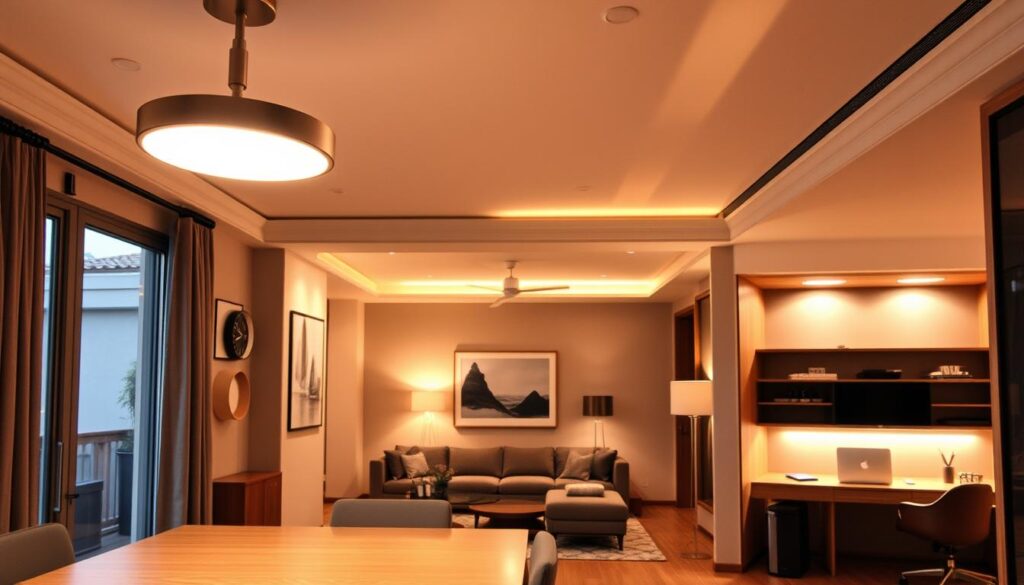
Smart Bulbs vs. Smart Switches
Homeowners often wonder between smart bulbs and switches. Smart bulbs are simple to put in and change color and brightness. Smart switches give a classic feel but also automate.
Your choice depends on what you need and your home’s setup.
Creating Lighting Scenes and Routines
Smart lighting lets you make special scenes and routines. You can set lights for movie nights, dinner, or just chill time. It makes your home feel just right for any moment.
And it’s easy to control with your phone or voice.
Energy-Saving Lighting Automation
Smart lighting saves energy too. It turns off lights when not needed or changes brightness with the time. This cuts down energy use.
It saves money on bills and helps the planet.
Smart Home Security Systems
Smart home security systems are changing how we protect our homes and families. Thanks to new tech, keeping your home safe is easier and more accessible than before.
Smart Doorbells and Cameras
Smart doorbells and cameras lead in home security. They offer live monitoring and alerts. These tools help watch your home’s entrance and area, keeping intruders away.
Installation and Placement Tips
For the best results, put smart doorbells and cameras where they’re clear and not blocked. Make sure they’re high enough to avoid tampering.
Features to Look For
When picking smart doorbells and cameras, look for high-definition video, night vision, motion detection, and cloud storage. These features help keep your home safe.
Smart Locks and Access Control
Smart locks add security and ease, letting you control your home’s access from afar. You can let guests in for a set time and then stop their access.
Integrated Security Monitoring
Integrated security systems combine different devices for a full view of your home’s safety. You can manage them from a central hub or app, getting alerts and updates in real-time.
| Security Feature | Description | Benefits |
|---|---|---|
| Smart Doorbells | Video doorbells with real-time alerts | Enhanced security, deterrence |
| Smart Cameras | Surveillance cameras with motion detection | Monitoring, evidence collection |
| Smart Locks | Keyless entry with remote access control | Convenience, controlled access |
Security experts say, “A smart home security system does more than protect your home. It also gives you peace of mind.”
“The use of smart tech in home security has greatly lowered home burglaries.”
— Security Industry Association
Climate Control and HVAC Automation
Now, making your home comfy is easier than ever. Thanks to smart climate control systems. These systems help you control your home’s heating, ventilation, and air conditioning (HVAC). They make your home cozy and cut down on energy use.
Smart Thermostats and Temperature Sensors
Smart thermostats are key in HVAC automation. They figure out your favorite temperatures and adjust the heat and cool. With temperature sensors around the house, they make sure each room is just right. This boosts comfort and saves energy.
Creating Energy-Efficient Heating and Cooling Schedules
Setting schedules lets you control your HVAC system. For example, lower the heat when you’re out or asleep. Raise it when you’re home or waking up. This makes your home comfy and saves energy.
| Feature | Benefit |
|---|---|
| Smart Thermostats | Learn your temperature preferences and adjust accordingly |
| Temperature Sensors | Ensure uniform temperature distribution throughout the house |
| Automated Schedules | Reduce energy consumption by adjusting temperatures based on your routine |
Smart Kitchen Appliances and Solutions
Smart kitchen appliances are changing how we cook and eat. They make our kitchens more efficient and innovative. This is thanks to IoT devices.
Connected Refrigerators and Cooking Appliances
Connected refrigerators and cooking appliances lead in smart kitchen tech. You can control and check them from anywhere. This makes planning meals and shopping easier.
For example, a smart fridge can track your food. It even suggests recipes based on what’s about to expire.
Smart Small Appliances and Gadgets
Smart small appliances and gadgets also play a big role. They make food prep easier and cooking more fun.
Coffee Makers and Beverage Systems
Smart coffee makers can brew coffee when you want it. This way, you always get a fresh cup.
Food Preparation Devices
Smart slow cookers and instant pots can be controlled with apps. You can change cooking settings from your phone.
Inventory Management Tools
Some smart appliances and apps help manage your kitchen’s inventory. They make it easy to keep track of what you have and need.
Using these smart kitchen appliances makes cooking more efficient and fun. It also makes your kitchen more connected.
Smart Bathroom Technology
Now, making your bathroom smart is easier than ever. The latest tech makes it possible.
Smart bathroom tech makes your daily routine better. It adds convenience, luxury, and saves time.
Smart Showers and Faucets
Smart showers and faucets change how we use the bathroom. They come with cool features like:
- Voice control for hands-free use
- Customizable temperature settings
- Water-saving sensors
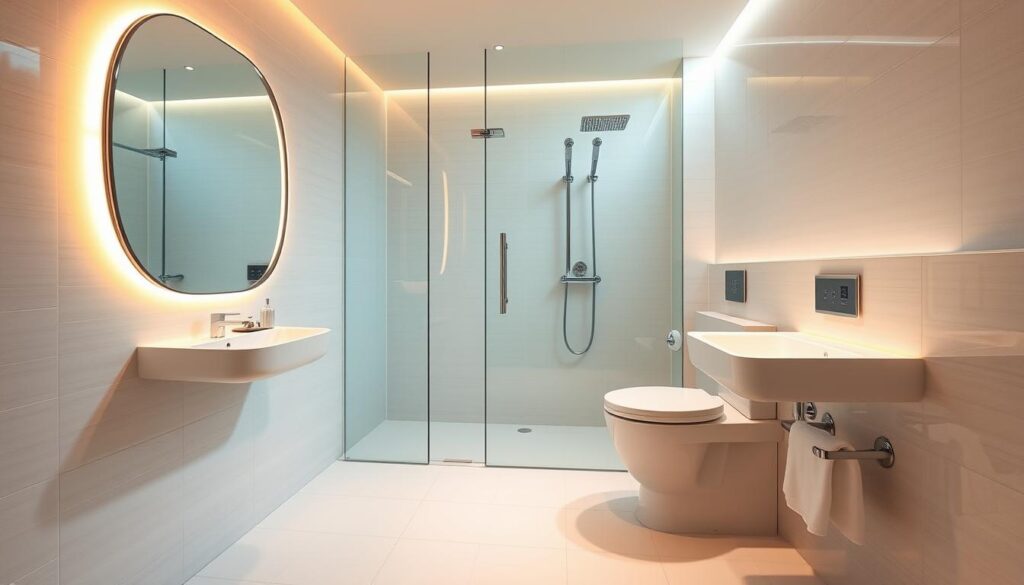
Intelligent Mirrors and Lighting
Intelligent mirrors and smart lighting change the bathroom’s feel:
- LED lights that match your mood
- Mirrors with displays for news and schedules
- Demister for clear views
Entertainment and Media Automation
Smart home devices have made entertainment and media automation real. They improve your viewing and listening experience. Now, you can easily control your home entertainment system, making it more fun and immersive.
Smart TVs and Streaming Devices
Smart TVs and streaming devices lead in entertainment automation. Brands like Samsung, LG, and Roku offer smart TVs that connect to the internet. This gives you access to many streaming services.
You can use voice commands or mobile apps to control these devices. This makes it simple to find and watch your favorite shows.
Multi-Room Audio Systems
Multi-room audio systems let you enjoy music all over your home. Systems from Sonos and Bose stream music wirelessly to different rooms. This creates a smooth audio experience.
You can control the volume, playback, and music selection with voice commands or a dedicated app. This makes listening to music easy and fun.
Voice-Controlled Entertainment
Voice control has changed how we interact with entertainment systems. Using voice assistants like Amazon Alexa or Google Assistant, you can control your TV, soundbar, or streaming device. Just use simple voice commands.
This hands-free control makes your entertainment experience better. It’s more convenient and enjoyable.
Smart Home Solutions for Energy Management
Smart home tech is more than just convenience. It helps make your home more energy-efficient. By using smart devices, you can cut down on energy use and save on bills.
Monitoring and Reducing Energy Consumption
Smart home tech is great for watching and managing energy use. You can use smart meters and systems to see how much energy you use. This helps you find ways to use less and save money.
Smart Power Management Devices
Smart devices are key to better energy use. These include:
Smart Plugs and Outlets
Energy Monitoring Systems
Solar Integration with Smart Homes
Smart plugs and outlets let you control and check each appliance’s energy use. Energy monitoring systems give you detailed info on your energy habits. Solar integration lets you use clean energy, cutting down on grid use and bills.
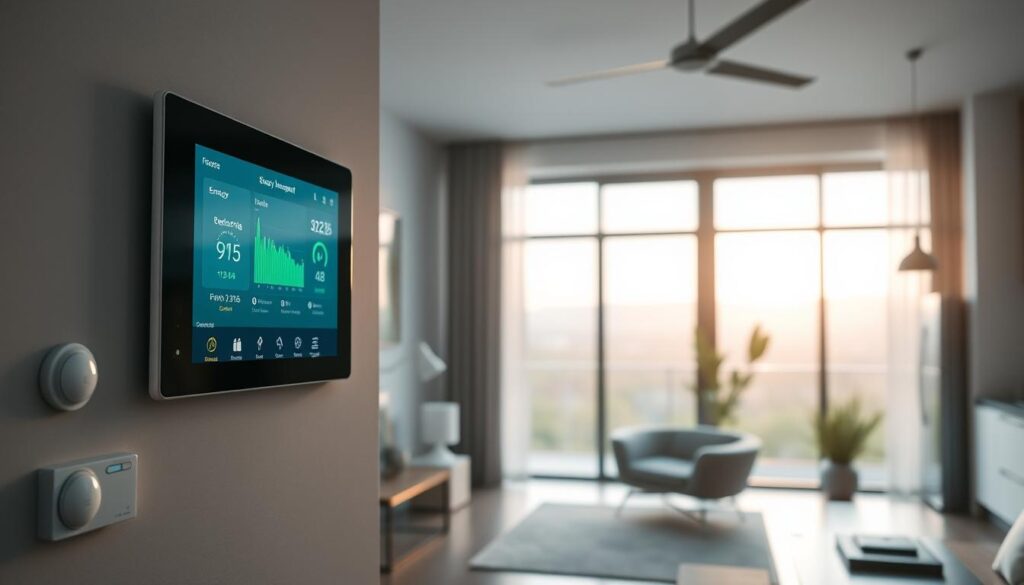
Using these smart home solutions makes your home more energy-smart. It’s better for the planet and saves you money over time.
Creating Automated Routines for Daily Life
Smart home automation lets you set up routines for daily tasks. This makes your life easier and more efficient. You can control many devices with just one command or schedule.
Morning and Evening Routines
Begin your day with a “Good Morning” routine. It opens curtains, starts the coffee, and plays your favorite podcast. An “Evening” routine can dim lights, lock doors, and adjust the thermostat to relax you.
Arrival and Departure Automations
Automate actions when you get home or leave. An “Arrival” routine can light up your home, adjust the temperature, and play music. A “Departure” routine turns off lights, locks doors, and activates security.
Special Occasion Settings
Smart home automation is great for special events too. For movie nights, it can dim lights, lower the screen, and set the sound system. This makes your events unique and easy to set up.
| Routine Type | Actions | Benefits |
|---|---|---|
| Morning/Evening | Control lighting, temperature, entertainment | Enhanced convenience, energy efficiency |
| Arrival/Departure | Secure home, adjust environment | Improved security, comfort |
| Special Occasions | Customize ambiance, entertainment settings | Unique experiences, ease of use |
Automated routines make your life more streamlined and efficient. They help you get the most out of your smart home system.
Smart Home Privacy and Security Concerns
Your smart home is convenient and innovative. But, it also has unique vulnerabilities. These need to be addressed to keep you safe and private. As you enjoy your connected home, know the risks and take steps to avoid them.
Protecting Your Connected Devices
Securing your smart devices is a big concern. With more IoT devices, cyber threats grow. To protect, you must use strong security measures.
Network Security Best Practices
Securing your home network is key. Use strong passwords, enable WPA3 encryption, and update your router often. These steps help block unauthorized access.
Regular Updates and Maintenance
Keep your smart devices and apps updated. Manufacturers release updates to fix security issues. Regular updates protect your smart home from threats.
Data Privacy Considerations
Smart devices collect and share personal data. It’s important to know what data is collected and how it’s used. Check privacy policies and adjust settings to protect your data.
Here’s a table showing common smart devices, the data they collect, and privacy risks:
| Smart Home Device | Data Collected | Potential Privacy Risks |
|---|---|---|
| Smart Speakers | Voice commands, search history | Unauthorized access to voice recordings, targeted advertising |
| Smart Security Cameras | Video footage, motion detection data | Unauthorized surveillance, data breaches |
| Smart Thermostats | Temperature settings, energy usage patterns | Data sharing with third parties, potential for energy usage profiling |
Knowing these risks and protecting your data helps you enjoy your smart home. You can keep your privacy and security safe.
Getting Started with Your Smart Home Journey
Starting a smart home journey can feel overwhelming. But with a good plan, you can make your home more convenient and efficient. It’s important to have a clear strategy from the start.
Planning Your Smart Home Strategy
First, think about what you need and want. Decide what parts of your home you want to make smarter, like lighting, security, or entertainment. A good plan helps you choose the right devices and makes sure they work together well.
Budget-Friendly Implementation Tips
Building a budget-friendly smart home is possible by starting small. Begin with key devices like smart thermostats or security cameras. Then, you can add more as you can, keeping your budget in mind.
“The key to a successful smart home is not just about having the latest technology, but about how it integrates into your daily life to make it more convenient and efficient.”
Phased Approach to Smart Home Integration
Using a phased smart home integration approach is smart. Start with one area, like lighting or entertainment, and then add more. This way, you can manage costs and keep things simple, making the process easier.
Conclusion
Exploring smart home technology shows many benefits. A connected home brings convenience, security, and saves energy and money. It adapts to your needs with IoT devices and home automation.
With a smart home hub and voice assistant, you can control your home from anywhere. This makes managing your day easier. You can upgrade your lighting, security, or entertainment systems as needed.
When making your home smart, remember to keep your data safe. Start with small steps and choose devices wisely. This way, you enjoy a connected home while protecting your privacy.
Smart home technology improves your life more than just your home. Start exploring today. Find a more convenient, secure, and connected way to live.

